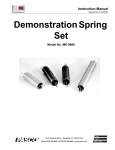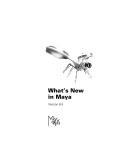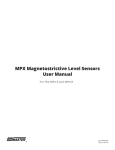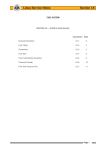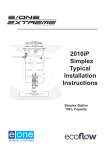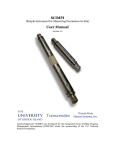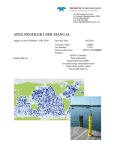Download PASCO Specialty & Mfg. ME-8569 User's Manual
Transcript
Instruction Manual and Experiment Guide for the PASCO scientific Model ME-8569 012-04774A 1/92 DENSITY SET Copyright © January 1992 $5.00 012-04774A Table of Contents Section Page Copyright, Warranty, and Equipment Return ................................................... ii Introduction ...................................................................................................... 1 Equipment ......................................................................................................... 1 Replacement Parts ............................................................................................ 2 Experiments Experiment 1: Length, Area, and Volume ............................................ 3 Experiment 2: Density .......................................................................... 5 Experiment 3: Buoyancy Force ............................................................ 7 Experiment 4: Specific Heat ............................................................... 11 i scientific 012-04774A Copyright and Warranty Please—Feel free to duplicate this manual subject to the copyright restrictions below. Copyright Notice will repair or replace, at its option, any part of the product which is deemed to be defective in material or workmanship. This warranty does not cover damage to the product caused by abuse or improper use. Determination of whether a product failure is the result of a manufacturing defect or improper use by the customer shall be made solely by PASCO scientific. Responsibility for the return of equipment for warranty repair belongs to the customer. Equipment must be properly packed to prevent damage and shipped postage or freight prepaid. (Damage caused by improper packing of the equipment for return shipment will not be covered by the warranty.) Shipping costs for returning the equipment, after repair, will be paid by PASCO scientific. The PASCO scientific Model ME-8569 Density Set manual is copyrighted and all rights reserved. However, permission is granted to non-profit educational institutions for reproduction of any part of this manual providing the reproductions are used only for their laboratories and are not sold for profit. Reproduction under any other circumstances, without the written consent of PASCO scientific, is prohibited. Limited Warranty PASCO scientific warrants this product to be free from defects in materials and workmanship for a period of one year from the date of shipment to the customer. PASCO Equipment Return Should this product have to be returned to PASCO scientific, for whatever reason, notify PASCO scientific by letter or phone BEFORE returning the product. Upon notification, the return authorization and shipping instructions will be promptly issued. NOTE: NO EQUIPMENT WILL BE ACCEPTED FOR RETURN WITHOUT AN AUTHORIZATION. When returning equipment for repair, the units must be packed properly. Carriers will not accept responsibility for damage caused by improper packing. To be certain the unit will not be damaged in shipment, observe the following rules: scientific ii 1. The carton must be strong enough for the item shipped. 2. Make certain there is at least two inches of packing material between any point on the apparatus and the inside walls of the carton. 3. Make certain that the packing material can not shift in the box, or become compressed, thus letting the instrument come in contact with the edge of the box. 012-04774A Introduction The PASCO Model ME-8569 Density Set allows useful experiments in density, buoyancy force, and specific heat as well as providing an effective means of distinguishing between length, volume, and area. Equipment SAME MASS The density set consists of six objects: • aluminum cylinder • aluminum cylinder • aluminum block • aluminum block • brass cylinder • brass block • brass block • aluminum irregular shape • polypropylene cylinder SAME DENSITY • aluminum irregular shape • aluminum cylinder Each object has a small hole through which a string can be tied to suspend the object. The objects in this set can be categorized in three different ways: those objects having the same volume, same mass, or same density. • aluminum block • aluminum irregular shape SAME DENSITY SAME VOLUME • aluminum cylinder • brass cylinder • aluminum block • brass block • brass cylinder • polypropylene cylinder • aluminum irregular shape scientific 1 012-04774A Replacement Parts ITEM PASCO PART NUMBER aluminum cylinder 648-04768 aluminum block 648-04772 brass cylinder 648-04770 brass block 648-04771 polypropylene cylinder 648-04769 aluminum irregular shape 648-04773 2 scientific 012-04774A Experiment #1: Length, Area, and Volume Calipers (SF-8711) B. Using the calipers, measure the width and height of one end of each of the blocks. Calculate the area of the end of the block by multiplying the width by the height. Record the results in Table 1.1. String (SE-8050) III. VOLUME Overflow can (SE-8568) A. By Calculation Beaker for catching water For each of the regularly-shaped objects, calculate the volume by multiplying the area of one end by the length of the object. Record in Table 1.1. REQUIRED EQUIPMENT: Density set Graduated cylinder (50 ml) B. By Displacement of Water PURPOSE: For each of the regularly-shaped objects, find the volume by finding the volume of water that each one displaces: The purpose of this experiment is to distinguish between length, area, and volume. 1. Put the beaker under the overflow can spout as shown in Figure 1. PROCEDURE 2. Pour water into the overflow can until it overflows into the beaker. Allow the water to stop overflowing on its own and empty the beaker into the sink and return it to its position under the overflow can spout without jarring the overflow can. I. LENGTH Using the calipers, measure the longest side of each of the five regularly-shaped objects. Record the results in Table 1.1. 3. Tie a string to each of the objects (including the irregularly-shaped object). II. AREA A. Using the calipers, measure the diameter of each of the three cylinders. Divide the diameter by two to get the radius, r. 4. Gently lower the first object into the overflow can until it is completely submerged. Allow the water to stop overflowing and then pour the water from the beaker into the graduated cylinder. Calculate the area of the circular end of the cylinders using: A = π r 2. Record the results in Table 1.1. Table 1.1: Length, Area, and Volume OBJECT LENGTH AREA VOLUME AL. CYL. AL. BLOCK BRASS CYL. BRASS BLOCK PLASTIC AL. IRREG. SHAPE scientific 3 DISPLACED VOLUME % DIFF. 012-04774A Measure the volume of water that was displaced by reading the water level in the graduated cylinder in milliliters (1 ml = 1 cm3). Record this volume in Table 1.1. ANALYSIS For each of the regular objects, calculate the percent difference between the two values found for the volume. 5. Repeat this procedure for the other objects. Note that the plastic object will float in water so it cannot be used in this part of the experiment. QUESTIONS 1. Which objects have nearly the same volume? 2. Which objects have nearly the same length? 3. Which objects have nearly the same cross-sectional area? 4. Did any two objects have the same volume but did not have the same length or the same area? Figure 1: Overflow Setup 4 scientific 012-04774A Experiment #2: Density REQUIRED EQUIPMENT: II. DISPLACED VOLUME Density set: brass cylinder and brass block For each of the two brass objects, find the volume by finding the volume of water that each one displaces: Calipers (SF-8711) 1. Put the beaker under the overflow can spout as shown in Figure 1. String (SE-8050) Overflow can (SE-8568) 2. Pour water into the overflow can until it overflows into the beaker. Allow the water to stop overflowing on its own and empty the beaker into the sink and return it to its position under the overflow can spout without jarring the overflow can. Beaker for catching water Graduated cylinder (50 ml) Triple-beam balance (SE-8708) 3. Tie a string to each of the objects. PURPOSE: 4. Gently lower the first object into the overflow can until it is completely submerged. Allow the water to stop overflowing and then pour the water from the beaker into the graduated cylinder. This experiment finds the densities of different-shaped objects made of the same material. PROCEDURE Measure the volume of water that was displaced by reading the water level in the graduated cylinder in milliliters (1 ml = 1 cm3). Record this volume in Table 2.1. Using the triple-beam balance, find the mass of the brass cylinder and the brass block. Record the results in Table 2.1. 5. Repeat this procedure for the other object. ANALYSIS I. CALCULATED VOLUME For each method of finding the volume, calculate the density, d, of each object using: d = mass volume Obtain the accepted value for the density of brass from your instructor or from a reference book. A. Cylinder Using the calipers, measure the length, L, of the brass cylinder. Record the results in Table 2.1. Measure the diameter of the cylinder. Divide the diameter by two to get the radius, r. Calculate the volume of the cylinder using: V = π r 2 L. For each experimental value of the density, calculate the percent difference from the accepted value and record the results in Table 2.2. Record the results in Table 2.1. B. Block Using the calipers, measure the length (L), width (W), and height (H) of the brass block. Calculate the volume of the block using: V = L x W x H. Record the results in Table 2.1. Table 2.1: Measurements OBJECT MASS DIMENSIONS VOLUME CYLINDER BLOCK scientific 5 DISPLACED VOLUME 012-04774A QUESTIONS 1. Which object took up more space? 2. Which object weighed more? 3. Which object was more dense? Table 2.2: Results ACCEPTED DENSITY VALUE = OBJECT CALCULATED DENSITY DENSITY BY DISPLACEMENT % DIFFERENCE FROM ACCEPTED CYLINDER BLOCK 6 scientific 012-04774A Experiment #3: Bouyant Force REQUIRED EQUIPMENT: Density set String (SE-8050) Overflow can (SE-8568) Beaker for catching water Graduated cylinder (50 ml) Triple-beam balance (SE-8708) PURPOSE: This experiment measures the buoyant force on an object in water by using Archimedes’ Principle and by finding the upward force on the object while it is submerged. PROCEDURE Figure 1: Overflow Setup I. ARCHIMEDES’ PRINCIPLE 2. Pour water into the overflow can until it overflows into the beaker. Allow the water to stop overflowing on its own and empty the beaker into the sink and return it to its position under the overflow can spout without jarring the overflow can. Archimedes’ Principle states that the buoyant force exerted on an object partially or fully submerged in a fluid will be equal to the weight of the fluid displaced by the object. To use this principle to find the buoyant force exerted on each object, follow these steps: 3. Tie a string to each of the objects. 4. Gently lower the first object into the overflow can until it is completely submerged. Allow the water to stop overflowing and then find the mass of the beaker with the water in it. Record this mass in Table 3.1. 1. Find the mass of the empty beaker and record this at the top of Table 3.1. Put the beaker under the overflow can spout as shown in Figure 1. Table 3.1: Measurements MASS OF BEAKER = OBJECT MASS OF BEAKER + WATER MASS OF WATER AL. CYLINDER AL. BLOCK BRASS CYL. BRASS BLOCK PLASTIC CYL. AL. IRREG. SHAPE BRASS CYL. 1/2 SUBMERGED scientific 7 WEIGHT OF DISPLACED WATER 012-04774A 5. Calculate the mass of the water by subtracting the mass of the beaker. Then calculate the weight of the displaced water by multiplying by the acceleration due to gravity (9.8 m/s2). Record the result in Table 3.1 and Table 3.2. Thus the buoyant force can be calculated by finding the difference between the weight of the object in air and the apparent weight of the object when it is submerged in water. 1. Put the triple-beam balance on top of a stand as shown in Figure 3. Tie a string to the bottom of the pan. 6. Repeat this procedure for the other objects. Note that the plastic object will float in water but it can still be used in this 2. Hang the first object from the string. The balance will read the same as when the object is placed on top of the pan. Multiply the mass by the acceleration due to gravity (9.8 m/s2) and record the object’s weight in Table 3.2. Buoyant Force 30 40 100 50 200 60 70 300 80 90 400 100g 500g SCALE Weight in air Weight in water Figure 2: Free Body Diagram part of the experiment. Also, repeat the procedure for the brass cylinder with only half the cylinder submerged. II. UPWARD FORCE When an object is submerged in a fluid, the apparent weight of the object is less than the weight in air because of the buoyant force (See Figure 2). Figure 3: Scale Setup Table 3.2: Measurements OBJECT WEIGHT IN AIR WEIGHT IN WATER BF = WAIR -W WATER WEIGHT OF DISPLACED WATER AL. CYLINDER AL. BLOCK BRASS CYL. BRASS BLOCK PLASTIC CYL. AL. IRREG. SHAPE BRASS CYL. 1/2 SUBMERGED 8 scientific 012-04774A 3. While the object is still hanging from the balance, submerge the object in a beaker of water so that the entire object is under water but it is not touching the sides or bottom of the beaker. Record the reading on the scale and multiply by gravity to get the apparent weight. Record in Table 3.2. QUESTIONS 1. In each case, is the buoyant force found using the difference between weights equal to the weight of the water displaced? 2. Which objects had the same buoyant force when submerged? 4. Calculate the buoyant force by taking the difference between the weight in air and the weight in water. Record in Table 3.2. Why? 3. For the plastic cylinder, what was the weight in water? 5. Repeat these steps for all the objects. Note that the plastic cylinder will float so don’t try to completely submerge it in the water. Also, for the half-submerged brass cylinder, find the apparent weight in the water when only half the cylinder is submerged. scientific 4. How was the buoyant force for the totally submerged brass cylinder related to the buoyant force for the halfsubmerged brass cylinder? 9 012-04774A Notes 10 scientific 012-04774A Experiment #4: Specific Heat EQUIPMENT REQUIRED: Density set: Aluminum and Brass cylinders and blocks String (SE-8050) Beaker for heating water Submerge mass in water Styrofoam cup Cold water Triple-beam balance (SE-8708) Bunsen burner Heating stand Thermometer (SE-9083) PURPOSE: This experiment shows that the specific heat of a material depends on the type of material but not on the amount of material. PROCEDURE The specific heat, c, of a material is defined to be the amount of heat needed to raise the temperature of one gram of the material one degree Celsius. To measure this heat, the method of mixtures will be used. The following procedure will be repeated for four objects (aluminum cylinder, aluminum block, brass cylinder, and brass block): Figure 1: Heating Setup 2. While waiting, find the mass of a dry styrofoam cup and then prepare a styrofoam cup of cold water (about 3°C below room temperature) into which the heated object can be completely submerged. When the object has finished heating, record the temperature of the cold water to the nearest tenth of a degree, then record the temperature of the boiling water, and quickly transfer the heated object from the hot water to the cold water (See Figure 2). Record in Table 4.1. 1. Heat a beaker of water to boiling. While the water continues to boil, hang the object by a string so that the object is completely submerged in the boiling water but it is not touching the bottom of the beaker. Allow the object to come to equilibrium with the boiling water (wait about 5 minutes). See Figure 1. Table 4.1: Data MASS OF CUP = OBJECT HOT TEMPERATURE COLD TEMPERATURE AL. CYL. AL. BLOCK BRASS CYL. BRASS BLOCK scientific 11 EQUILIBRIUM TEMPERATURE MASS OF WATER 012-04774A Thermometer 7. When the object is cooled in the water, the heat lost by the object is equal to the heat gained by the water because energy is conserved (neglecting any losses to the environment): Submerge mass in water ∆QOBJECT = ∆QWATER (mc∆T )OBJECT = (mc∆T )WATER Solving for the specific heat of the object gives: c= Figure 2: Equilibrium Temperature mWATERcWATER (∆T )WATER mOBJECT(∆T )OBJECT where cWATER is 1 cal/g °C. Calculate the specific heat for the object and record the results in Table 4.2. 3. Watch the temperature of the cold water rise, stirring the water gently. After several minutes, the temperature will peak out (above room temperature) and began to fall. Record this equilibrium (peak) temperature to the nearest tenth of a degree in Table 1. 8. Look up the accepted value for the specific heat for the material used and record in Table 4.2. Calculate the percent difference between the experimental value and the accepted value. 4. After the equilibrium temperature has been reached, remove the object from the water and weigh the water with the cup. Subtract the mass of the cup from the mass of the water with the cup and record the mass of the water in Table 4.1. QUESTIONS 9. Repeat this procedure for the other objects. 1. Do the two aluminum objects have the same specific heat? 5. Calculate the change in temperature for the object: 2. Do the two brass objects have the same specific heat? ∆T = HOT TEMP - EQUILIBRIUM TEMP. 3. How does starting the cold water below room temperature minimize the effect of the losses to the environment? Record this in Table 4.2. 6. Calculate the change in temperature for the water in the styrofoam cup: ∆T = EQUILIBRIUM TEMP - COLD TEMP. Record this in Table 4.2. Table 4.2: Calculations OBJECT OBJECT ∆T WATER ∆T SPECIFIC HEAT ACCEPTED VALUE % DIFF. AL. CYL. AL. BLOCK BRASS CYL. BRASS BLOCK 12 scientific Technical Support Feedback Contacting Technical Support If you have any comments about the product or manual, please let us know. If you have any suggestions on alternate experiments or find a problem in the manual, please tell us. PASCO appreciates any customer feedback. Your input helps us evaluate and improve our product. Before you call the PASCO Technical Support staff, it would be helpful to prepare the following information: To Reach PASCO For technical support, call us at 1-800-772-8700 (toll-free within the U.S.) or (916) 786-3800. fax: (916) 786-3292 e-mail: [email protected] web: www.pasco.com ➤ If your problem is with the PASCO apparatus, note: - Title and model number (usually listed on the label); - Approximate age of apparatus; - A detailed description of the problem/sequence of events. (In case you can’t call PASCO right away, you won’t lose valuable data.); - If possible, have the apparatus within reach when calling to facilitate description of individual parts. ➤ If your problem relates to the instruction manual, note: - Part number and revision (listed by month and year on the front cover); - Have the manual at hand to discuss your questions.


















